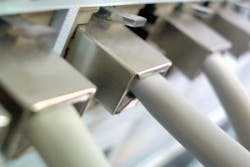Eye on Video: When analog cameras outlive their DVRs
As an IP video guy, every time I go through U.S. Customs at Boston’s Logan Airport I’m struck by all the analog cameras that still hang on the wall behind each officers’ booth. I’ve crossed that checkpoint dozens of times over the past decade and those cameras continue to mock me.
It also makes me realize that this type of longevity brings up an interesting problem for users. While an analog camera typically remains in operation for eight years or more, the DVR it’s attached to usually fails in half that time. In the lifecycle of an analog CCTV system, a customer would have to replace each DVR at least once, but likely more.
That 2-1-plus ratio opens a whole new world of opportunity for network video integrators while providing better value for the customer. If the integrator replaces expired DVRs with more future-proof video encoders, they not only extend the life of the customer’s current analog camera investment, but the technology puts them on a migration path to a full IP-based solution and all its associated benefits.
As the analog cameras themselves begin to fail, they can be replaced with more advanced IP cameras, allowing customers to upgrade their surveillance system in affordable increments.
How big a market are we talking about?
According to the global research firm IHS Inc., by 2014 new sales of IP video will account for 50 percent of the revenue in the video surveillance market. While this indicates that the battle for supremacy is starting to tip in favor of IP technology, it’s important to recognize the flip side of this story. Of the more than 50 million video cameras currently installed around the world today more than 80 percent of them are analog.
For the sake of argument, let’s say that a majority of them are attached to 16-channel DVRs. That means there are more than 2.5 million DVRs currently aging across the globe that could be candidates for replacement. That’s a huge market opportunity for video encoders, and one that would be foolish to ignore.
Why are video encoders better than DVRs?
A DVR is the most expensive, maintenance-heavy, proprietary PC your customer will ever buy. A video encoder, on the other hand, is an open-platform technology that can take a customer’s existing legacy analog cameras and essentially turn them in to IP cameras. Swapping video encoders for end-of-life DVRs affords users some significant advantages:
• Scalability: DVRs come in fixed channel increments – 4, 8, 16, etc. Video encoders are available in one-channel versions that can be placed close to the analog camera, or in multi-channel versions with up to 84 channels per chassis. This means that customers can add channels in any increment they need, creating a more cost-efficient mechanism for future expansion of their surveillance system. And once the head-end has been migrated to IP, new network cameras can be added to the system one- or many-at-a-time wherever an Ethernet drop is available.
• Performance: DVRs are typically strapped for processing power and therefore performance. So they commonly stream video at 7.5 or 15 frames-per-second (fps) per channel. Video encoders can stream at 30 fps and sometimes even higher. The higher the fps, the smoother the video and the better the image, which leads to much-improved surveillance coverage.
• Storage: An average DVR box holds one to four terabytes of video. But since it’s a proprietary, closed platform, it offers customers limited scalability. An encoder-based solution is an open platform that can attach to common off-the-shelf storage, so it’s more cost effective and scalable to virtually unlimited retention capacity.
• Intelligence: In an analog system, intelligence needs to be performed by the DVR along with all the other tasks such as compression and storage. With a closed platform, the customer often can only select from the limited intelligence applications available from that specific DVR vendor. Video encoders can support third-party intelligent applications running inside the encoder, which provides flexibility to build a best-of-breed solution and ensures there is enough computing performance for the video channels. Digitizing the signal also allows the customer to select much more intelligent video management software from any leading global provider.
• Redundancy: If the DVR fails the whole CCTV system fails – and then the system is down for however long it takes to fix or replace the DVR. Encoders offer a number of redundancy options to keep the surveillance system up and running. For example, you can power one- or four-channel encoders via Power-over-Ethernet and tie them into the UPS system in the server room. Some encoders have dual power supplies built in. Some have a blade system where the channels can be hot swapped if a blade fails. Some encoder rack solutions have redundant network ports. Some have all of the above.
• Future-proof: Once the analog cameras need replacing, most of the DVR-based system needs to be forklifted. With an encoder-based system, you can simply integrate new IP cameras one camera at a time.
What’s new with encoder technology?
Many integrators assume that with the phasing out of analog technology nothing new has been happening in the world of video encoders. That’s simply not true. Manufacturers are continuing to invest R&D in video encoder technology. Prices continue to drop as performance continues to improve. Some new encoder enhancements include:
• Performance: The latest encoders support up to 60 fps, which delivers smooth video even in high motion scenes. There have also been significant advancements in noise reduction, image sharpness and image contrast for even better picture quality.
• Density: New video encoder blades support up to 84 analog cameras, making them ideal for large, mission-critical surveillance installations. Furthermore, video encoder blades can be hot swappable, so there’s no need to power down the whole system when installing or removing individual blades. Unlike swapping out failed DVRs, critical surveillance systems that leverage video encoders stay up and running during upgrades.
• Support for PTZ over coax: Some encoders support control of PTZ cameras using the coax cable, which limits the amount of cabling needed in an installation.
• Onboard storage: Today’s encoders often include SD-card slots for onboard storage. In a small system with only a few cameras, the SD-card can serve as the sole recording device. In an enterprise system, the SD-card can provide redundant recording. A typical 64GB SD-card today is around $50 and can store several days of recording, or sometimes even longer if motion-based recording is used.
• Fiber output: SFP (small form-factor pluggable) fiber slots make it easier to integrate certain encoders into newer fiber-based network infrastructures. This is commonly the case in large retail stores or warehouses where the distances between MDF closets might be long.
With more than 40 million analog cameras still in operation around the world, it’s worth your while to investigate this huge opportunity for replacing failed DVRs with video encoders. Getting a foot in the door with this bridging technology can be your first step in building a long-term customer relationship.
First the customer will realize greater value from their existing analog camera. Then as that legacy technology begins to age out, you’ll have already laid the foundation to help the customer gradually migrate to a full IP solution and all its accompanying benefits.
About the Author: Fredrik Nilsson is the general manager for Axis Communications, Inc. in North America. He has more than 16 years of experience with IP video systems and is the author of "Intelligent Network Video: Understanding Modern Video Surveillance Systems," published by CRC Press.
About the Author

Fredrik Nilsson
Fredrik Nilsson is VP Americas for Axis Communications, and is the author of “Intelligent Network Video: Understanding Modern Video Surveillance Systems” published by CRC Press and now in its second edition. www.axis.com
Request more info about Axis at www.securityinfowatch.com/10212966.
